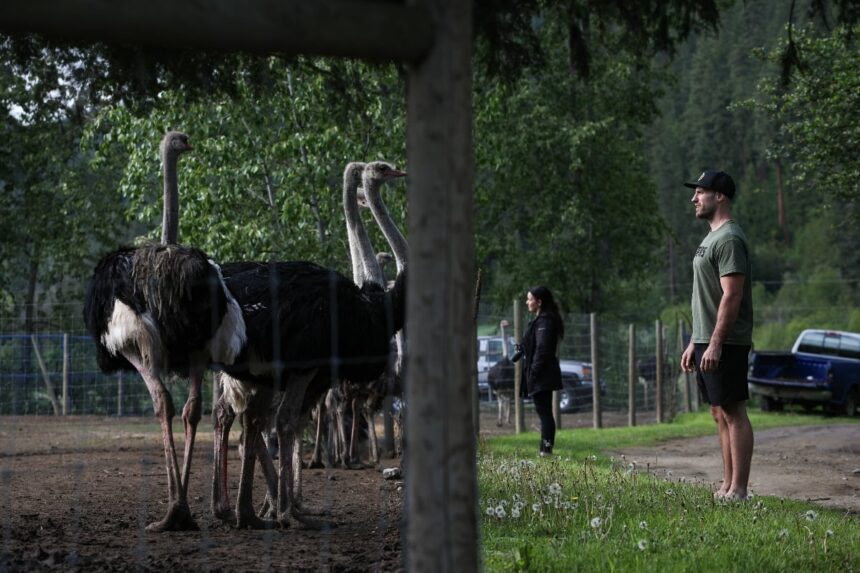The federal government’s plan to cull thousands of ostriches in British Columbia’s Fraser Valley has been temporarily suspended after the BC Supreme Court granted an emergency injunction late yesterday afternoon.
Justice Marion Wells issued the 14-day stay following an emergency application from the BC Ostrich Farmers Association, which argued the Canadian Food Inspection Agency (CFIA) failed to consider less drastic alternatives before ordering the destruction of approximately 15,000 birds across 23 farms.
“This injunction doesn’t solve the underlying issue, but it gives these farmers their day in court,” said Priya Sharma, lead counsel for the association, outside the courthouse. “The government can’t simply destroy an entire agricultural sector without proper scientific justification and consultation.”
The dispute stems from an April detection of a novel strain of avian influenza at two Fraser Valley farms. After initial testing, CFIA officials claimed the strain showed unusual transmission patterns and ordered a preventative cull across the region, citing potential risks to the broader poultry industry and public health.
I reviewed the 86-page court filing, which reveals the core of farmers’ legal challenge rests on three arguments: inadequate scientific evidence supporting the necessity of mass culling, failure to consider less destructive containment measures, and procedural errors in the emergency order process.
The Canadian Veterinary Medical Association has taken an unusual step by submitting an independent statement to the court questioning the scale of the planned cull. “While precautionary principles in disease management are important, the evidence threshold for destroying thousands of healthy animals must be substantially higher,” wrote Dr. Elaine Foster, the association’s president, in documents obtained through court records.
For Fraser Valley farmers like Martin Chen, who has raised ostriches for 12 years, the court’s decision represents a temporary lifeline. “These birds represent millions in investment and decades of careful breeding,” Chen told me during a farm visit last week. “Once they’re gone, you can’t simply restart this industry overnight.”
The unusual case highlights tensions between emergency powers granted to federal agricultural authorities and the rights of producers. Under the Health of Animals Act, the CFIA can order the destruction of animals to prevent disease spread, but must demonstrate reasonable grounds for such actions.
Daniel Lefebvre, professor of agricultural law at University of British Columbia, notes this case could establish important precedent. “The court is essentially being asked to determine how much scientific certainty is required before taking devastating economic action against an agricultural sector,” Lefebvre explained. “It’s about balancing precaution against proportion.”
Documentation from the CFIA, available through their public portal, shows initial testing identified the virus as a variant H5N8 strain. However, independent analysis commissioned by the farmers’ association from the University of Saskatchewan’s Vaccine and Infectious Disease Organization suggests the virus may be less transmissible than initially reported.
The potential economic impact extends beyond just the farms. BC’s ostrich industry generates approximately $28 million annually in meat, leather, and feather products, according to provincial agriculture ministry data. Nearly 200 jobs could be affected by the cull decision.
Federal officials maintain their position despite the temporary setback. “We respect the court process but remain concerned about potential risks to other poultry operations and wildlife,” said CFIA spokesperson Jean-Philippe Arsenault. “Our scientists have documented sufficient risk to justify precautionary measures.”
The legal challenge reveals a broader pattern of tension between federal agricultural authorities and specialty livestock producers. Court records show three similar disputes over disease management protocols have occurred since 2018, though none reached this scale.
Environmental groups have also entered the fray, with the BC Wildlife Federation expressing concern about potential virus transmission to wild bird populations. “While we understand the farmers’ position, there are complex ecosystem considerations that must factor into these decisions,” said conservation director Rebecca Taylor.
Meanwhile, farmers have proposed alternative measures including enhanced quarantine protocols, expanded testing regimes, and isolated culling only where active infections are confirmed. Their court filings include a detailed 30-page management plan developed in consultation with veterinary experts.
As the legal battle unfolds, both sides are preparing for a full hearing scheduled for early July. The court will need to weigh complex scientific evidence alongside legal questions about administrative procedure and proportionality.
For Chen and other farmers, the waiting is excruciating. “Everything we’ve built is in limbo,” he said, watching his birds from the fence line. “But at least now we have a chance to prove these birds don’t need to die.”
The case has drawn attention from agricultural sectors across Canada, with several provincial farming associations filing supporting briefs. Legal observers suggest the outcome could influence how disease management decisions are made and challenged in the future.
As one CFIA whistleblower told me on condition of anonymity, “The agency’s internal protocols for evidence assessment in emergency situations have been questioned before. This case might finally force a more transparent approach.”
The court’s full hearing is scheduled for July 8th.






